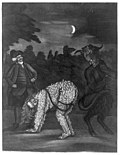Tarring and feathering



Tarring and Feathering was a form of public humiliation and punishment used to enforce unofficial justice or revenge. It was never legally sanctioned by any government but was practiced by informal groups. The process involved covering an individual with hot tar followed by feathers. This act was often carried out by vigilante groups to punish or intimidate individuals who were seen as wrongdoers or outsiders within a community.
History[edit]
The origins of tarring and feathering are difficult to trace, but the practice was used in medieval Europe and became more common in the 18th century, particularly in Britain and the American colonies. It was often associated with the American Revolution, where it was used by both Patriots and Loyalists as a form of mob justice against those who opposed their political views.
Procedure[edit]
The procedure of tarring and feathering could vary, but it typically involved heating tar until it was liquified. The tar was then applied to the naked body of the victim, either with a brush or by pouring it directly onto them. After the tar was applied, feathers were thrown onto the sticky substance, adhering to the body. The tar used was generally pine tar, a substance more commonly used for waterproofing ropes and ships. It was not as hot as modern industrial tar and was unlikely to cause serious burns, but the process was still extremely painful and humiliating.
Social and Political Implications[edit]
Tarring and feathering was more than just a physical punishment; it served as a powerful tool of social ostracism. Victims were often paraded through the streets, further enhancing the public humiliation. The act was a clear message from the community or group performing the punishment, indicating that the victim's actions or presence was not tolerated. It was used against tax collectors, political figures, and others who were seen as betraying community interests.
Decline[edit]
The practice began to decline in the 19th century as societies moved towards more formalized systems of justice. However, isolated incidents of tarring and feathering were reported into the early 20th century, particularly in rural areas.
In Popular Culture[edit]
Tarring and feathering has been depicted in various works of literature and film, often to highlight the brutality of mob justice or the plight of individuals facing community ostracism.
Legal and Ethical Considerations[edit]
From a modern perspective, tarring and feathering is considered a form of cruel and unusual punishment. It violates principles of human rights and dignity and would be illegal under current laws in most jurisdictions.
Gallery[edit]
-
John Meintz, punished during World War I
-
John Meintz, punished during World War I
-
Huck Finn Travelling by Rail
-
A tarred and feathered man standing on hands and feet
-
Mother's Angel (1920)
See Also[edit]
External Links[edit]
- History of Tarring and Feathering - History.com
Ad. Transform your life with W8MD's Budget GLP-1 injections from $75


W8MD offers a medical weight loss program to lose weight in Philadelphia. Our physician-supervised medical weight loss provides:
- Weight loss injections in NYC (generic and brand names):
- Zepbound / Mounjaro, Wegovy / Ozempic, Saxenda
- Most insurances accepted or discounted self-pay rates. We will obtain insurance prior authorizations if needed.
- Generic GLP1 weight loss injections from $75 for the starting dose.
- Also offer prescription weight loss medications including Phentermine, Qsymia, Diethylpropion, Contrave etc.
NYC weight loss doctor appointmentsNYC weight loss doctor appointments
Start your NYC weight loss journey today at our NYC medical weight loss and Philadelphia medical weight loss clinics.
- Call 718-946-5500 to lose weight in NYC or for medical weight loss in Philadelphia 215-676-2334.
- Tags:NYC medical weight loss, Philadelphia lose weight Zepbound NYC, Budget GLP1 weight loss injections, Wegovy Philadelphia, Wegovy NYC, Philadelphia medical weight loss, Brookly weight loss and Wegovy NYC
|
WikiMD's Wellness Encyclopedia |
| Let Food Be Thy Medicine Medicine Thy Food - Hippocrates |
Medical Disclaimer: WikiMD is not a substitute for professional medical advice. The information on WikiMD is provided as an information resource only, may be incorrect, outdated or misleading, and is not to be used or relied on for any diagnostic or treatment purposes. Please consult your health care provider before making any healthcare decisions or for guidance about a specific medical condition. WikiMD expressly disclaims responsibility, and shall have no liability, for any damages, loss, injury, or liability whatsoever suffered as a result of your reliance on the information contained in this site. By visiting this site you agree to the foregoing terms and conditions, which may from time to time be changed or supplemented by WikiMD. If you do not agree to the foregoing terms and conditions, you should not enter or use this site. See full disclaimer.
Credits:Most images are courtesy of Wikimedia commons, and templates, categories Wikipedia, licensed under CC BY SA or similar.
Translate this page: - East Asian
中文,
日本,
한국어,
South Asian
हिन्दी,
தமிழ்,
తెలుగు,
Urdu,
ಕನ್ನಡ,
Southeast Asian
Indonesian,
Vietnamese,
Thai,
မြန်မာဘာသာ,
বাংলা
European
español,
Deutsch,
français,
Greek,
português do Brasil,
polski,
română,
русский,
Nederlands,
norsk,
svenska,
suomi,
Italian
Middle Eastern & African
عربى,
Turkish,
Persian,
Hebrew,
Afrikaans,
isiZulu,
Kiswahili,
Other
Bulgarian,
Hungarian,
Czech,
Swedish,
മലയാളം,
मराठी,
ਪੰਜਾਬੀ,
ગુજરાતી,
Portuguese,
Ukrainian





